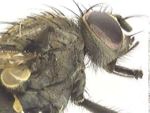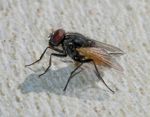Musca spp.
Jump to navigation
Jump to search
- Also known as 'house' and 'face' flies
- Includes Musca domestica the house fly and Musca autumnalis the face fly
- Found in temperate regions
- The house fly is present both inside and outside of buildings
- The face fly is one of the most numerous flies which annoy cattle
- Attracted to the head and upper parts of the body
Recognition
- 7.5mm long
- Sponge-like labellum mouthparts
- Grey thorax with longitudinal stripes
- Yellow abdomen with a single black stripe
Life Cycle
- Eggs laid in rotting manure, hatch and pass through pupal and larval stages before emerging
- Eggs hatch within 12 hours of being deposited
- Life cycle takes 12 days
- Flies may overwinter as adults
Pathogenesis
- Production losses
- Reduced weight gain
- Reduced milk yield
- Fly worry
- Disease transmission
- Viruses
- E.g. Coxsackie, enteroviruses, poliomyelitis
- Bacteria
- Helminths
- E.g. Intermediate hosts for Habronema in horses, some poultry tapeworms, Parafiliaria and Thelazia in cattle
- Viruses
- Feeds on secretions from the eyes, nose and mouth as well as blood left in wounds by other flies
Control
- Fly control in breeding and resting sites (to reduce the source)
- Breeding sites
- Good sanitation
- Collect dung in heaps
- Spray surface of heaps with insecticide to kill surviving adults and larvae
- Biological control
- Resting sites
- Spray inside and outsides of buildings with insecticide
- Breeding sites
- Fly control on the host
- Wide range of products available
- Nil or short withdrawal period needed for milking animals or animals going for slaughter

